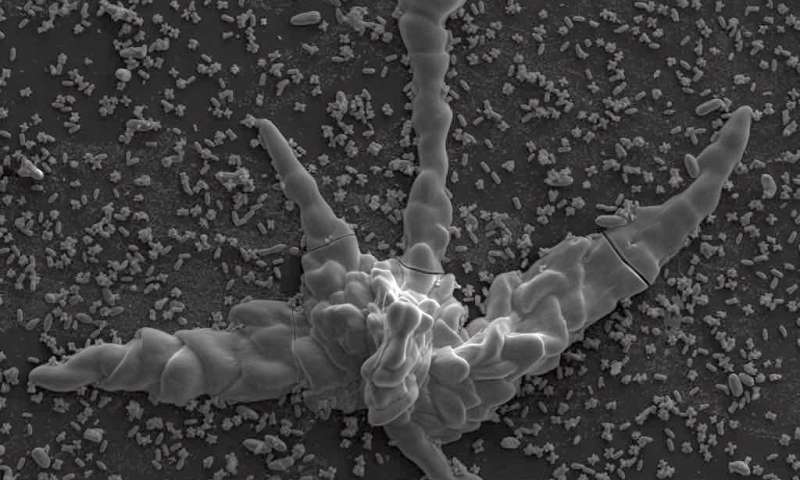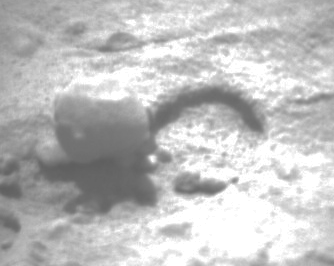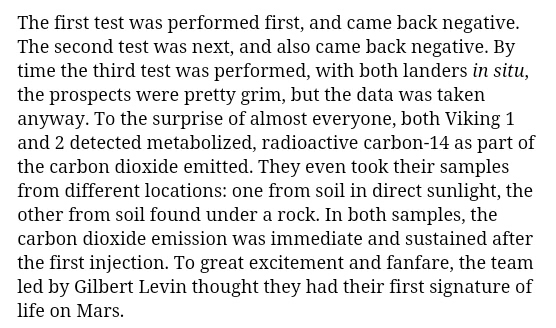It looks like you're using an Ad Blocker.
Please white-list or disable AboveTopSecret.com in your ad-blocking tool.
Thank you.
Some features of ATS will be disabled while you continue to use an ad-blocker.
Detecting ET Life Trickier Than Ever - Scientists Find Inorganic Structures That Mimic Fossils
page: 18
share:
Finding life outside of our terrestrial biosphere just got a lot more difficult. An international team of researchers discovered that inorganic
chemicals can self-organize into complex structures that mimic primitive life on Earth.

Source
Now we shouldn't have any doubts that this international team has done their work correctly. But it does feel a bit like a conspiracy in the making. With this rationale, TPTB could potentially delay the announcement of ET indefinitely. Unless of course we come across something that is in fact "alive", moving and breathing (perhaps on Titan, Europa?). But regarding the possible fossil record on Mars (in case NASA's 2020 Mars rover should come across interesting microscopic shapes in the soil), this could be a good excuse to not announce anything "earth-shaking", yet again.
Bad news, me thinks. But I look forward to what ATS has to say... so over to you now!

Fossil or inorganic structure? Scientists dig into early life forms
Florida State University Professor of Chemistry Oliver Steinbock and Professor Juan Manuel Garcia-Ruiz of the Consejo Superior de Investigaciones Cientificas (Spanish National Research Council) in Granada, Spain published an article in Wednesday's edition of Science Advances that shows fossil-like objects grew in natural spring water abundant in the early stages of the planet. But they were inorganic materials that resulted from simple chemical reactions (...)
Source
Now we shouldn't have any doubts that this international team has done their work correctly. But it does feel a bit like a conspiracy in the making. With this rationale, TPTB could potentially delay the announcement of ET indefinitely. Unless of course we come across something that is in fact "alive", moving and breathing (perhaps on Titan, Europa?). But regarding the possible fossil record on Mars (in case NASA's 2020 Mars rover should come across interesting microscopic shapes in the soil), this could be a good excuse to not announce anything "earth-shaking", yet again.
Bad news, me thinks. But I look forward to what ATS has to say... so over to you now!
edit on 16-3-2017 by jeep3r because: text
Granted I don't understand fossils and inorganic chemicals but it seems this could open a can of worms we as humanity aren't really prepared to
consider. That's not even mentioning the direction you are afraid it will go.
a reply to: jeep3r
Well, I'm sure you know that Ex-NASA Astrobiologist Richard Hoover already maintains that a Crinoid fossil was obliterated by a rover on Mars after a short while. (Google gallery below) It's pretty clear that Hoover does know his stuff, and while considered controversial by some over other claims, even there the hubbub has cooled down somewhat.
www.google.co.uk...,ssl&ei=3xzLWOez G-nXgAabpbGADQ
It could be a crafty to settle malaise on the subject, but it's also pretty clear that regular, and regularish recurring non biological forms do happen, both on Earth and on Mars and anywhere else for that matter.
Thing is say, in the first picture it is given as a biomorph, what would a biologist have to say about that picture, what would an astrobiologist have to say about it, and what would they all say about it if they all knew its origin.
Well, I'm sure you know that Ex-NASA Astrobiologist Richard Hoover already maintains that a Crinoid fossil was obliterated by a rover on Mars after a short while. (Google gallery below) It's pretty clear that Hoover does know his stuff, and while considered controversial by some over other claims, even there the hubbub has cooled down somewhat.
www.google.co.uk...,ssl&ei=3xzLWOez G-nXgAabpbGADQ
It could be a crafty to settle malaise on the subject, but it's also pretty clear that regular, and regularish recurring non biological forms do happen, both on Earth and on Mars and anywhere else for that matter.
Thing is say, in the first picture it is given as a biomorph, what would a biologist have to say about that picture, what would an astrobiologist have to say about it, and what would they all say about it if they all knew its origin.
edit on 16-3-2017 by smurfy because: Text.
originally posted by: sputniksteve
Granted I don't understand fossils and inorganic chemicals but it seems this could open a can of worms we as humanity aren't really prepared to consider. That's not even mentioning the direction you are afraid it will go.
What can of worms? Which direction? Why so afraid?
originally posted by: bender151
a reply to: jeep3r
I'd settle for a picture of a planet that isn't an artist's rendition...
I know, it's very hard to use Google, isn't it?
Here are some pics of Jupiter taken through an amateur telescope: astronomy-imaging-camera.com...
Of course, you could set up your own telescope and a camera, and take pictures of planets yourself, just to be sure they're really there.
originally posted by: jeep3r
Finding life outside of our terrestrial biosphere just got a lot more difficult. An international team of researchers discovered that inorganic chemicals can self-organize into complex structures that mimic primitive life on Earth.
It's not really news, as we've all heard of those infamous meteorites that contain "ET fossils" that could very well be inorganic formations.

However, this research just proves that we mustn't cry "ALIENS!" every time we see something resembling a fossil. Something ATSers should take onboard.
a reply to: wildespace
Your image shows the Alan Hills Mars meteorite found in the 1980s in Antarctica, if I'm right. It's said to contain the fossil remains of an early extraterrestrial lifeform and I don't think this claim has been refuted yet (meaning it could indeed show primitive ET life from early Mars).
But you're kind of proving my point with this example: any features in images like that which we may get from another planet in future, will most likely be interpreted as being "inorganic". We just added another layer of doubt to the whole discussion, making it more and more difficult to identify extraterrestrial organisms under such conditions.
Your image shows the Alan Hills Mars meteorite found in the 1980s in Antarctica, if I'm right. It's said to contain the fossil remains of an early extraterrestrial lifeform and I don't think this claim has been refuted yet (meaning it could indeed show primitive ET life from early Mars).
But you're kind of proving my point with this example: any features in images like that which we may get from another planet in future, will most likely be interpreted as being "inorganic". We just added another layer of doubt to the whole discussion, making it more and more difficult to identify extraterrestrial organisms under such conditions.
a reply to: jeep3r
The chemistry will give it away however. It is almost as if chemical analysis will have to go hand in hand with every discovery like this, as it should. We have already eliminated photography as proof of anything, as that technology has been refined so well that we can fool ourselves with it.
The chemistry will give it away however. It is almost as if chemical analysis will have to go hand in hand with every discovery like this, as it should. We have already eliminated photography as proof of anything, as that technology has been refined so well that we can fool ourselves with it.
originally posted by: bender151
a reply to: jeep3r
I'd settle for a picture of a planet that isn't an artist's rendition...
You'll be waiting forever, if you want some of planets in other systems, because of the sad inevitability of Rayleigh's criterion. It sets a physics bar on the resolution of aperture limited imaging.
It'll take a lot more work on metamaterial lenses to break with that, and even then, it'll STILL take a miracle. No photo for you.
For Sol system, you can get decent images of Mercury, Venus, Mars, Jupiter, Saturn. The others not so good, unless they're from a flyby. No details, mind you, because of Rayleigh. But at least you can get an idea.
edit on 17-3-2017 by Bedlam because: (no reason given)
Wasn't there a Rooskie back in the late 60s, early 70s who actually found some weird life forms in meteors and was considered a crank and never heard
from again?
originally posted by: smurfy
a reply to: jeep3r
Well, I'm sure you know that Ex-NASA Astrobiologist Richard Hoover already maintains that a Crinoid fossil was obliterated by a rover on Mars after a short while. (Google gallery below) It's pretty clear that Hoover does know his stuff, and while considered controversial by some over other claims, even there the hubbub has cooled down somewhat.
www.google.co.uk...,ssl&ei=3xzLWOez G-nXgAabpbGADQ
It could be a crafty to settle malaise on the subject, but it's also pretty clear that regular, and regularish recurring non biological forms do happen, both on Earth and on Mars and anywhere else for that matter.
Thing is say, in the first picture it is given as a biomorph, what would a biologist have to say about that picture, what would an astrobiologist have to say about it, and what would they all say about it if they all knew its origin.
The good old "crinoid-on-mars" example, to me it's convincing but you're right that they'd all officially claim it's nothing but concretions of some kind, especially when reminding them that it's located on Mars.
The morphology debate was already difficult enough in the past. But these recent news won't make it easier to make a good case for ET life in terms of microfossils and it seems we'd need a lot more data to actually prove it (IF we find some fossilized remains resembling primitive lifeforms, that is).
originally posted by: charlyv
a reply to: jeep3r
The chemistry will give it away however. It is almost as if chemical analysis will have to go hand in hand with every discovery like this, as it should. We have already eliminated photography as proof of anything, as that technology has been refined so well that we can fool ourselves with it.
If the chemical analysis would allow for a positive identification then we'd have the ideal situation. But the article also states that this might turn out to be not so easy:
"Inorganic microstructures can potentially be indistinguishable from ancient traces of life both in morphology and chemical composition," Garcia-Ruiz said.
The whole fuzz and confusion could of course be avoided either by finding "extant" life or by coming across features offering more "context" (such as the remains of different lifeforms in the same area). Someone said it before: where there used to be life, there was once probably lots of it thriving in that particular ecosystem.
So they finally figured that out, huh? I found this a couple years ago in a Mars photo:

And here's a Mars worm. Not.


And here's a Mars worm. Not.

edit on 17-3-2017 by Blue Shift because: (no reason given)
new topics
-
Pentagon acknowledges secret UFO project, the Kona Blue program | Vargas Reports
Aliens and UFOs: 38 minutes ago -
Boston Dynamics say Farewell to Atlas
Science & Technology: 46 minutes ago -
I hate dreaming
Rant: 1 hours ago -
Is the origin for the Eye of Horus the pineal gland?
Philosophy and Metaphysics: 3 hours ago -
Man sets himself on fire outside Donald Trump trial
Mainstream News: 3 hours ago -
Biden says little kids flip him the bird all the time.
2024 Elections: 3 hours ago -
The Democrats Take Control the House - Look what happened while you were sleeping
US Political Madness: 4 hours ago -
Sheetz facing racial discrimination lawsuit for considering criminal history in hiring
Social Issues and Civil Unrest: 4 hours ago -
In an Historic First, In N Out Burger Permanently Closes a Location
Mainstream News: 6 hours ago -
MH370 Again....
Disaster Conspiracies: 6 hours ago
top topics
-
In an Historic First, In N Out Burger Permanently Closes a Location
Mainstream News: 6 hours ago, 14 flags -
The Democrats Take Control the House - Look what happened while you were sleeping
US Political Madness: 4 hours ago, 10 flags -
Thousands Of Young Ukrainian Men Trying To Flee The Country To Avoid Conscription And The War
Other Current Events: 16 hours ago, 8 flags -
A man of the people
Medical Issues & Conspiracies: 11 hours ago, 8 flags -
Man sets himself on fire outside Donald Trump trial
Mainstream News: 3 hours ago, 7 flags -
Biden says little kids flip him the bird all the time.
2024 Elections: 3 hours ago, 6 flags -
4 plans of US elites to defeat Russia
New World Order: 13 hours ago, 4 flags -
Is the origin for the Eye of Horus the pineal gland?
Philosophy and Metaphysics: 3 hours ago, 4 flags -
Sheetz facing racial discrimination lawsuit for considering criminal history in hiring
Social Issues and Civil Unrest: 4 hours ago, 3 flags -
Are you ready for the return of Jesus Christ? Have you been cleansed by His blood?
Religion, Faith, And Theology: 8 hours ago, 3 flags
active topics
-
-@TH3WH17ERABB17- -Q- ---TIME TO SHOW THE WORLD--- -Part- --44--
Dissecting Disinformation • 543 • : SideEyeEverything1 -
Elites disapearing
Political Conspiracies • 33 • : 0bserver1 -
Man sets himself on fire outside Donald Trump trial
Mainstream News • 29 • : ByeByeAmericanPie -
Fossils in Greece Suggest Human Ancestors Evolved in Europe, Not Africa
Origins and Creationism • 78 • : strongfp -
Pentagon acknowledges secret UFO project, the Kona Blue program | Vargas Reports
Aliens and UFOs • 2 • : Macenroe1982 -
In an Historic First, In N Out Burger Permanently Closes a Location
Mainstream News • 8 • : KrustyKrab -
12 jurors selected in Trump criminal trial
US Political Madness • 104 • : Annee -
Russian intelligence officer: explosions at defense factories in the USA and Wales may be sabotage
Weaponry • 175 • : Freeborn -
Thousands Of Young Ukrainian Men Trying To Flee The Country To Avoid Conscription And The War
Other Current Events • 36 • : Xtrozero -
Are you ready for the return of Jesus Christ? Have you been cleansed by His blood?
Religion, Faith, And Theology • 19 • : glend
8

